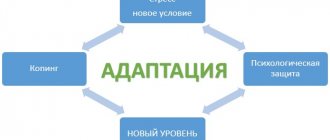Altruism is not a very common phenomenon these days. Altruists delight some, surprise others, and cause suspicion among others. What character traits do these people have, is it easy to become an altruist, what theories of altruism exist, and is such a character trait really necessary? Let's look at all these questions in more detail in our article.
Charity without sentimentality
Charity has ceased to be an activity for a narrow group of philanthropists. According to VTsIOM, over the past 10 years the number of Russians who donate to charity has increased 8 times. The growth of the volunteer movement and the number of charitable organizations can be considered one of the most important changes that have occurred in the country during this time.
Political scientist Ekaterina Shulman calls this process a “Russian civil Renaissance”: people are increasingly willing to donate their time and money to help others and jointly solve problems that the state cannot solve.
Most people want to help, but they doubt that their contribution can really benefit anyone.
According to statistics, the most common form of charity is still donations on the streets, targeted assistance to the sick via SMS and bank transfers, as well as collecting small change in stores and shopping centers. People usually donate one-time and impulsively. As a result, assistance turns out to be ineffective or even harmful, ending up in the hands of fraudsters and swindlers.
According to the Need Help Foundation, 90% of people participate in charity in one way or another. However, 47% do not remember which charity they donated to, and another 72% do not track where their money goes. Only 3% are signed up for recurring payments, the type of donation considered most effective.
Even the most noble intentions often lead to bad consequences. Orphanages filled with New Year's gifts; fraudulent fees for dying children on social networks; Fake foundations that help non-existent sick people are all forms of useless or harmful charity that should be avoided.
There is nothing wrong with sympathy for victims and satisfaction from a good deed - as long as these feelings do not force you to close your eyes to the surrounding reality.
Members of the growing social movement of effective altruism believe that to make the world a better place, we need not good intentions, but accurate data. If we really want to help others, the emotional impulse must be supplemented with logic and sober calculation.
What prevents you from effectively helping others?
Psychologists distinguish two types of people who donate to charity. The former make small donations from time to time and are not particularly interested in the future fate of their money. People from the second group choose one area - for example, the fight against cancer - and spend a significant share of their energy and resources on it. Both make decisions about whom to help, under the influence of random circumstances. In the first case, it may be a collector who stops us on the street. In the second, there is a relative who has cancer.
Members of the effective altruism movement believe that both of these approaches are flawed. Feelings push us to action, but they really prevent us from bringing maximum benefit.
When we lose a loved one, we care that they suffered and died before their time, not that they died for a specific reason. Sadness should be curbed by all means to make the world a better place. We should focus our impulse on preventing death and improving life in general, rather than preventing death and improving life in one very specific way.
From the book “Mind for Good” by William MacAskill
Research by economists shows that we are more likely to give up our time and money when there is an opportunity to impress others.
In exchange for a small donation, we receive what psychologists call a “warm glow” feeling. The dopamine reward system, the same areas of the brain that get excited when you eat a delicious dessert or receive a gift, is activated.
The desire to feel kind and good often prevents us from helping effectively. One of the reasons psychologists call the identifiable victim effect: it is much easier for us to sympathize with one person than with a group.
The death of a specific person turns into a tragedy, and the death of millions of people into a statistical summary. This is why targeted assistance is so popular rather than regular donations to funds.
But even if our money goes to those who need it, we will only help one person. This is good, but not enough.
“Imagine walking into a burning building, kicking down the door, running into the smoke and flames, and carrying your child out,” MacAskill suggests. The next day you save a drowning man, then dodge a bullet. You can rightfully feel like a hero after this. But in reality, you can do much more - save not just one or two, but hundreds of lives.
Altruism: what is it?
Under altruism
imply a principle of behavior in which a person performs good deeds, selflessly caring for the well-being of other people.
Essentially, the principle of altruism is to “live for the sake of others.” The term was first used by the founder of sociological science, Auguste Comte. By the concept, he meant the selfless motives of an individual, leading to actions that benefit only other people.
Psychologists have put forward an oppositional opinion to Comte's definition. According to their findings, in the long term, altruism provides more benefits than the effort expended on it. It was also concluded that altruists to some extent perform good actions with a degree of selfishness. Allegedly, a person gets special pleasure from the fact that people in whose affairs he took a significant part achieve success.
At the same time, egoism is still considered as the opposite of altruism. With selfishness, a person puts the satisfaction of his own interests first, elevating this to a life position.
Usually altruism manifests itself in caring, acts of mercy, self-denial for the sake of someone. It is important that in this case, healthy egoism is inherent in the individual, albeit to a lesser extent, giving primacy to good intentions.
Altruism can be mixed with various social experiences, such as sympathy, sympathy, goodwill and others. Altruistic actions that extend beyond the boundaries of friendship, family, and neighbors are called philanthropy, and people who are distinguished by such impulses towards those who are outside their acquaintance are called philanthropists.
Psychologists believe that gender also matters in altruism. Men are characterized by short-term impulses towards good deeds (helping to push a car, pulling a drowning person out of sea water, etc.). Women tend to take long-term actions (giving up a career to care for a sick relative). Vivid examples of altruism can be seen in volunteering, donation, and mentoring.
How to become an effective altruist
Every year, millions of people die from serious illnesses, suffer from mental disorders and are unable to escape poverty. If you look closely, it turns out that almost everyone needs help. But our strength and resources are limited - it is impossible to let through all the world’s troubles, much less solve them.
Therefore, it is very important to set your priorities correctly. To do this, MacAskill suggests focusing on four main questions:
- Scale. What is the significance of this problem? Does it greatly affect people's lives in the short and long term?
- Neglect. How many resources are spent on solving the problem? Is there any reason to believe that the problem will not be solved by the market or the state?
- Solvability. Are there solutions to the problem? How reliable is the evidence that these solutions work?
- Personal suitability. Given your skills, resources, knowledge, connections, and passions, how likely are you to add value in this field?
For example, global poverty is a very large-scale problem that affects millions of people. The suffering of animals on factory farms is a less significant but neglected problem because few people are addressing it. But victims of disasters that the whole world is watching are better off not sending their money - most likely, it will be more useful elsewhere.
A terrorist attack with 50 victims receives more attention than the annual death of 5 million children from preventable diseases. But everyday disasters are no less important than exceptional ones.
Many effective altruists focus on existential risks—threats that could destroy humanity and all its untapped potential. This includes the issue of nuclear disarmament and research into the safety of artificial intelligence. Philosopher Nick Bostrom calculated that unfriendly AI could destroy 1,052 potential lives. Although the likelihood of this event occurring is low, the results are so catastrophic that it is worth putting as much effort as possible into preventing it from happening.
Alexander Berezhnoy,
participant in the effective altruism movement:
“Effective altruism is about flexibility and constantly updating your ideas about the world based on reliable evidence. At the beginning of the 20th century, hardly anyone would have said that the greatest danger of the century would be nuclear weapons. It's the same today. Perhaps mental health and improving the recommendation services of Facebook and YouTube, where people spend billions of hours a day, are more important issues and more resources need to be directed towards them.”
Theories of altruism
Sociologists and psychologists have long been studying the motives of behavior of altruists, having come up with interesting theories:
Social
From a sociological point of view, several main theories of altruism can be distinguished: evolutionary, social exchange, social norms. They complement each other, and individually do not provide a complete understanding of why individuals are willing to provide help to others free of charge.
The theory of social exchange is based on the concept of deep egoism. Adherents of the theory believe that subconsciously a person who takes a selfless step first calculates his own benefit.
According to the theory of social norms, altruism is considered as a social responsibility. This means that altruistic deeds are an element of natural social norms inherent in society.
According to evolutionary theory, altruism is a part of development that helps in preserving the gene pool and is the driving force of evolution.
It is not easy to determine all the facets of this concept, taking into account only social research. It is also important to remember the so-called “spiritual” components of any individual.
Psychological
According to the theory of psychologists, the basis of altruistic behavior is the reluctance to observe the torment and experiences of other individuals. This feeling may be present at the subconscious level.
Another popular theory is that altruism is a consequence of guilt, and by doing good deeds a person tries to atone for guilt.
How to choose an effective altruistic profession
You can give back not only through donations, but also through your career. The choice of work directly affects how much good or harm we bring to the world. It is not necessary to volunteer for the Red Cross or hospice. Charity and social work are far from the only ways to make the world around you a better place.
The authors of the “80,000 hours” project from the University of Oxford recommend that when choosing a profession, you should not be guided by the call of your heart and calls to “follow your dreams.” Instead, you should try to understand where you can most effectively serve the greater good.
Alexander Berezhnoy:
“There are many ways a career can help solve social problems:
- Earning to give (earn to give). Get a high-paying job and donate, say, 10% of your income to effective organizations. But in Russia, income in absolute terms is lower than in the US or Europe, so this is definitely not a default strategy.
- Research . Career in science or think tanks. For example, in the field of computer science you can work on the security of artificial intelligence.
- Activism, Politics and Journalism . Many problems (for example, nuclear safety and biological weapons safety) are resolved only at the political level.
- Work in NGOs, social entrepreneurship . Get a job at a charity or donate part of your time as a volunteer. For those who want to start their own cost-effective NPO, there is the Charity Entrepreneurship incubator.”
The area in which your tendency towards altruism will be realized to the maximum can be determined using a special test.
How to compare the effectiveness of charitable programs
Where should we focus our efforts to help the maximum number of people? Oxford University graduates Toby Ord and William MacAskill asked this question several years ago. In 2009, they began researching charitable programs to see which ones provided the most value per dollar spent.
It turned out that some programs are more effective than others, not by one and a half to two times, as they expected, but by tens and hundreds of times.
For example, training one guide dog in the United States costs about $48,000. For the same amount of money in third world countries, a simple operation can restore the sight of about a thousand people. GiveWell estimates that saving one life would cost about $3,400 if donated to a fund that provides anti-malaria nets to African families. Of course, this is not as spectacular as saving a child from a burning house, but no less effective.
Proponents of effective altruism believe that completely different things can be compared with each other - for example, treating AIDS and getting rid of blindness. One of the tools they use for this is the QALY (quality-adjusted life year) metric, which measures the number of quality-adjusted life years. According to patient surveys, people on average rate life with untreated AIDS as 50% of life in full health, and life in a blind state as 40%. Therefore, antiretroviral therapy for one patient will provide less benefit than treatment for a blind person.
Research and calculations make it possible to compare different types of philanthropy with each other and determine which intervention will bring the greatest benefit. This can lead to very unexpected and counterintuitive conclusions.
Want to improve the academic performance of children in poor countries? Give them medicine for parasitic worms instead of buying new textbooks. Do you want to make a difference with your career? It is better to work not as a volunteer in Africa, but as a broker on Wall Street: this way you will earn a lot of money and be able to help more people through regular donations.
Effective altruism has grown into an international movement with thousands of followers and has been endorsed by public figures ranging from Bill Gates to Steven Pinker.
But such a cold and balanced approach to mutual assistance causes criticism and rejection among many. This is no accident. Like many good ideas, a performance mindset becomes less of a good idea when taken to its extreme.
Why you don’t want to be an effective altruist
Imagine walking past a small lake and seeing a child drowning in it. If you decide to save him, your best suit and expensive shoes will be hopelessly ruined. Chances are, you won't even think about the cost of the boots and will immediately jump into the lake.
According to philosopher Peter Singer, we find ourselves in this situation all the time.
With small donations to philanthropy, we could literally save other people's lives. Buying new shoes instead of participating in charity in this case is the same as walking past a drowning person.
For us these are incomparable things, but this is solely due to the weakness of our imagination. We do not see other people's suffering in front of us - but this does not mean that they do not exist.
Singer has been called the father of effective altruism. He comes from the ethics of utilitarianism, which states: you need to act in such a way as to maximize benefit - that is, to help as many people as possible. By this logic, you should sacrifice your own well-being in all cases if you lose less than someone else gains.
It's better to ruin your shoes but save someone's life. It's better to push one person under a train, but save five.
Utilitarianism makes no distinction between races and nationalities. If all people suddenly became utilitarians, Russian charities would immediately lose their money. Donations will do more good in Africa, which means they should be sent there. Even if you earn only 50,000 rubles a month, you are in the top 10% of the richest population in the world. Your money will benefit others more, so it's worth sharing at least some of it.
The 19th-century utilitarian philosopher Henry Sidgwick called this “the point of view of the universe.” All lives have the same value, and helping Russian patients rather than African ones means acting unfairly, subjecting to the random circumstances of one’s birth.
These arguments are quite logical, but to most people they will seem deeply incorrect. Peter Singer believes that the problem is the limitations of human psychology.
We are used to taking care of our group members, which is why we have lived in small communities for almost our entire history. Everything that leaves the “monkey sphere” of 100–150 people does not concern us.
But we can expand this sphere - that’s why we need intelligence. We must overcome these limitations to become more humane and rational.
But what's wrong with caring more about the well-being of loved ones than the well-being of strangers? As philosopher John Gray reminds us, the universe still does not have its own point of view - and if it does, it is not available to us. It is not surprising that the suffering of African children concerns us less than the suffering we see in our own country, city or home. Good deeds are usually driven by sympathy for specific people, and not for abstract humanity.
Effective altruism has been criticized for its engineering approach to charity, which reduces human suffering to a quantitative problem. If we start comparing and measuring unhappiness, we tend to favor some unhappy people over others.
From here it is not far to totalitarian logic, in which it is permissible to sacrifice one group of people for the sake of everyone’s happiness. But this step is not at all necessary.
But most effective altruists still do not support radical utilitarianism and absolute impartiality. They are unlikely to insist that we stop giving money to Russian foundations and taking care of loved ones. They consider it a human trait that must be taken into account. We cannot do without emotions: without them, we would completely stop helping someone - like patients with damage to the limbic system who cannot make even the simplest decisions.
Yes, maybe your loved ones are no more important to the universe than your neighbors' loved ones. But the social model, in which you take care of the people living in your home, is still effective in its own way.
To be an effective altruist, one does not have to give up personal attachments. The main thing is to realize that good intentions are not enough for a good deed.
First you are motivated by emotions, and then you start thinking. If we truly want to help others, it is important not to skip any of these steps.
How altruism improves a person's psychological state
How often do you selflessly help others? Do you enjoy doing it and do you feel better afterwards? The journal Clinical Psychological Science published an article
that selflessly helping others can relieve us of stress, as well as improve our emotional state and psychological well-being.
Helping others is not a waste of time
How memories lie
A discussion of the video interview format in the editorial office of Gazeta.Ru inspired the science department to find out what scientists now know about human memory, as well as to find out... →
Study author Emily Ansell says that,
By doing nice little things for others, we can easily improve our busy day and correct our bad mood.
After successful laboratory experiments showing that helping others can help manage one's own stress, scientists at Yale University School of Medicine decided to test whether this effect holds true in everyday life. Psychologists conducted a two-week study in which 77 participants aged 18 to 44 were asked to write down daily events that happened during the day, as well as their feelings about it.
The subjects were asked to report any stressful moments that occurred during the day in different areas: work, study, household chores, health. People also had to tell what they did that was useful for others that day (for example, they helped someone carry heavy bags, complete a task at work, or even just hold the door on public transport). In addition, participants were asked to rate their psychological state on a scale from 0 (“feeling bad”) to 100 (“feeling great”).
The results of the study showed that
Terrorists are not born
What is going on in the minds of terrorists, how suicide bombers overcome the fear of death and why children are taught to kill, the science department looked into... →
helping others improved the psychological state of the experiment participants. The more subjects helped someone, the higher their scores on positive emotions and mental well-being rose.
An inverse relationship was also observed: the less people helped someone during the day, the higher the tension and level of negative emotions of the participants.
Emily Ansell is surprised by how uniform the effect was across the entire sample. According to her, if participants helped others on fairly stressful and busy days, stress still did not manage to neutralize the positive effect of helping others.
Altruism as prescribed by a doctor
In the future, the researchers plan to expand this study to determine whether this phenomenon has cultural and ethnic characteristics. Scientists consider it especially important to find out whether actively involving others in doing good deeds will further improve mood and mental health. This would help clarify whether the prescription of prosocial altruistic behavior can help cope with tension in people who often experience high stress and depressed mood.
The findings of this study confirm a number of results obtained by psychologists about the human need for altruism as one of the most important components realized in communication.
The fewer witnesses the better
How to manipulate justice
Our decisions are very easy to manipulate: magnetic stimulation of a certain area of the brain changes a person’s ideas about justice... →
Psychologists are sure that the need for mercy, altruism and selfless behavior is formed as a result of “helping behavior” to others and increases a person’s self-esteem, allowing him to experience feelings of involvement in good deeds and human empathy.
However, altruistic behavior can also pursue selfish goals, and its manifestation is sometimes influenced by situational factors and personality traits.
Thus, Bib Latan and John Darley found back in 1968 that the number of eyewitnesses influences the manifestation of helping behavior. At first glance, it may seem that a large number of witnesses “encourages” a person to show his best qualities and help others, but in fact, the opposite happens.
If a crowd surrounds the scene of an accident, each person thinks: why should I help when there are so many other people around?
In one of the experiments conducted by scientists, student participants were asked to discuss the topic of adapting to highly competitive university life and talk about personal problems, and for convenience and less embarrassment they were seated in different rooms. Each participant in turn had the opportunity to speak into a microphone for two minutes, then the microphone was switched to another participant. The subjects were convinced that they were in a group of two, three or six people, they simply did not see the other interlocutors.
How to recognize a lie
Attempts to detect lies based on a person's facial expressions and gestures are no more effective than flipping a coin, scientists said.
About that... → In fact, the participant was always alone and “talked” to the voices on the tape. The researchers believed that the situation of an accident could clearly show the pattern of actions of people in groups of different sizes. The first of the recorded participants casually admitted to his interlocutor in his first speech that he experiences epileptic seizures after experiencing stress. A little later, this student allegedly began to have a seizure. For the subjects it looked convincing - like an accident. Next, the researchers recorded how many participants and in what time frame decided to help the “poor fellow” and ran to inform the experimenters about what happened. The results showed:
The more members there are in the group, the greater the delay in the time of assistance. In the two-participant group (when the subject was face-to-face with the epileptic), help was provided in less than a minute in 100% of cases.
In a group of three people, in 85% of cases, the average delay was more than three minutes. In a group of six people - 60%, the delay is more than four minutes.
In addition, scientists know that experiencing success increases people's desire to help others, while experiencing failure weakens it. But car drivers are more willing to take hitchhikers with them if they look them in the eyes when talking.
Happy people help more often
How the psychology of Soviet people has changed
I figured out how the psychology of the Soviet and post-Soviet generations differed, what the Soviet man was afraid of and why raising children in a crisis is dangerous... →
If we talk about the influence of personality traits on a person’s propensity for altruism, it is very difficult to compile an exhaustive list of them. Certain patterns can still be identified: for example, in 1991, a group of researchers discovered that
The most prone to altruistic behavior and helping others are highly emotional, empathetic people, as well as those who are prone to independent decision-making and have high self-control.
Women and people associated with religion are more likely to engage in altruistic behavior than others, as are happy people.
One way or another, the phenomenon of altruism has not yet been fully revealed and, perhaps, further research will reveal a lot of new things in this area. Who knows, maybe in the near future we will learn to completely minimize the damage from stress and emotional overload by helping the people around us.










